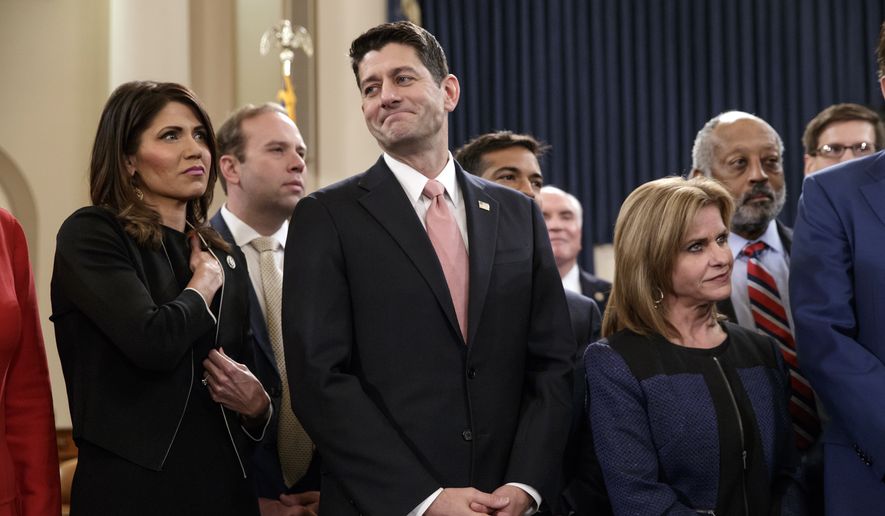Buried amid the deductions and credits, House Republicans have made a major shift in tax policy that will mean an escalating tax increase on every American taxpayer over the ensuing decades.
Republican tax-writers have decided to shift the tax code’s inflation index from the Consumer Price Index, or CPI, to something known as chained CPI, which is a slower-growing method of calculating cost-of-living increases.
Using the lower rate of inflation to calculate future tax rates means taxpayers will more quickly fall into higher tax brackets, meaning they will pay more in taxes than if Republicans stuck with the traditional measuring stick.
It works out to taxpayers paying $128 billion more to Uncle Sam than they would otherwise over the next decade, and $500 billion more in the subsequent decade.
“It’s a sneaky political move. It’s a hidden tax increase that will be invisible to voters,” said Chris Edwards, director of tax policy studies at the Cato Institute and editor of DownsizingGovernment.org. “There’ll be no newspaper story explaining there’s a tax increase every year, but that’s essentially what this will be.”
Cost-of-living adjustments are built into most of the federal budget and have been for decades. The theory is that as a dollar doesn’t stretch as far, taxpayers shouldn’t be asked to pony up as if it did — and the government needs to boost spending on benefit programs just to keep pace with consumers’ needs.
That means that numbers in the tax code change every year. For example, the standard deduction was $6,200 for a single taxpayer in 2014 but rose to $6,300 in 2015. The point at which the top tax rate kicked in was $406,750 in 2014, rising to $413,201 in 2015.
The rate of increase is based on the Consumer Price Index for all Urban Consumers, or CPI-U, and it measures increases in costs for more than 200 items of food, clothing, housing, energy and services needed for day-to-day living.
In 2002, the government began publishing the chained CPI, which uses a different method of averaging and looks at a broader time frame — chaining months together — which many economists say is the yardstick the government should use.
“Chained CPI is absolutely a more accurate measure of inflation,” said Marc Goldwein, senior vice president at the Committee for a Responsible Federal Budget. “All economists that aren’t being hackish agree that chained CPI is better.”
In general, chained CPI grows more slowly than the traditional measures. The Congressional Budget Office says it lags by about a quarter of a percentage point.
For a single year, that doesn’t make much difference. But the effects build up over time.
The Tax Policy Center crunched the numbers on the Republicans’ framework this year and calculated that taxpayers would pay $125 billion more over the next 10 years using chained CPI instead of the current method. In the decade following, it will be $500 billion.
Joseph Rosenberg, senior research associate at the center, said the decision about switching is a question about what policymakers are trying to do.
“You might be moving toward a more accurate measure of inflation, but you’re moving away from indexing for real growth,” he said. “Bracket creep — people get richer over time, move into higher brackets. To the extent you think that’s a problem, then you’re moving in the wrong direction.”
For years, Republicans have fought to use chained CPI as the inflation index on the spending side. That would mean automatic benefits such as Social Security would increase at a slower rate, saving taxpayers trillions of dollars over time.
Democrats have resisted, saying slower growth would be tantamount to a benefit cut.
Analysts said there was always a deal out there — Republicans would agree to subject the tax code to chained CPI, producing more revenue, while Democrats would agree to subject spending to chained CPI, saving taxpayers money.
Republicans’ unilateral decision on taxes could upset that balance.
Mr. Goldwein said he believes Republicans acting alone make it tougher to get chained CPI on the spending side because it takes away the leverage for a trade. Mr. Rosenberg said he thinks it makes it easier.
But he said the biggest use may be helping Republicans conform to complex Senate budget rules. Having that much additional revenue in future years can offset the growing losses from other tax cuts.
Indeed, the GOP plan announced Thursday called for switching to chained CPI in 2023. Just a day later House Ways and Means Chairman Kevin Brady announced an update that switches to chained CPI beginning next year, earning hundreds of billions of dollars in additional budget space.
Steve Ellis, vice president at Taxpayers for Common Sense, said if a lower inflation yardstick is right for one part of the federal fiscal picture, it should be used for all parts.
He said Mr. Trump — who has recently reaffirmed his opposition to adjusting Social Security or Medicare — may have made it harder to negotiate a deal. But he said if Republicans are successful in adjusting the tax side, it paves the way for changes in the future.
“The more you see chained CPI, the more likely you’re going to see if everywhere. If it’s the right measure, it’s the right measure,” he said.
For most of the history of the tax code there was no automatic indexing. Congress every couple of years would adjust the brackets upward to account for inflation, and would get credit for cutting taxes.
But during the Reagan administration Congress decided to build indexing into the code.
Mr. Edwards said congressional Republicans who cast themselves as following in the footsteps of Reagan should take note.
“It’s a bit of an anti-Reagan policy to reduce the amount of indexing in the tax code,” he said.
• Stephen Dinan can be reached at sdinan@washingtontimes.com.




Please read our comment policy before commenting.